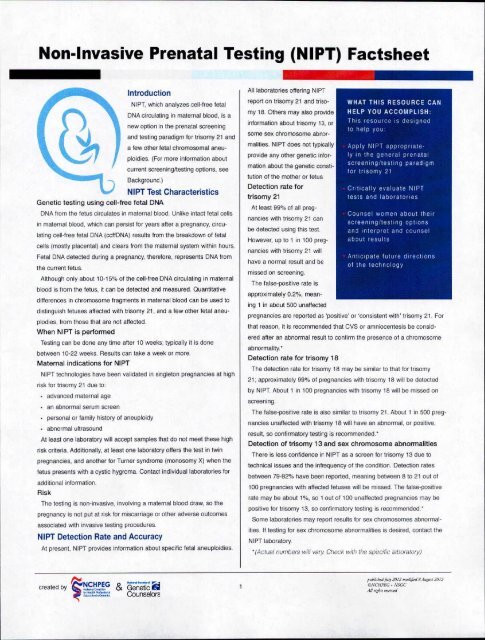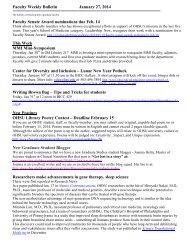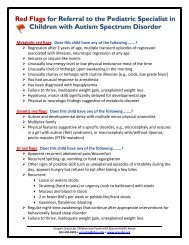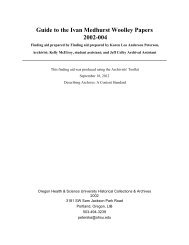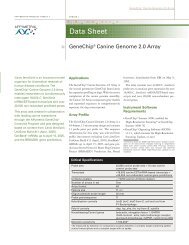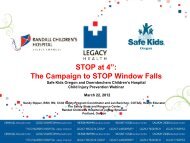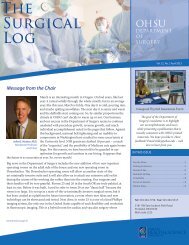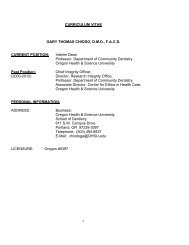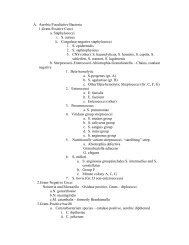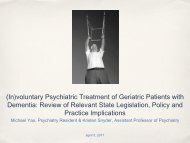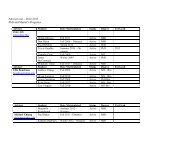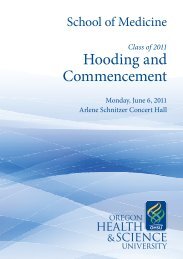Non-Invasive Prenatal Testing (NIPT) Faetsheet
Non-Invasive Prenatal Testing (NIPT) Faetsheet
Non-Invasive Prenatal Testing (NIPT) Faetsheet
You also want an ePaper? Increase the reach of your titles
YUMPU automatically turns print PDFs into web optimized ePapers that Google loves.
<strong>Non</strong>-<strong>Invasive</strong> <strong>Prenatal</strong> <strong>Testing</strong> (<strong>NIPT</strong>) <strong>Faetsheet</strong><br />
f::!created<br />
by WS:t?:~&<br />
Introduction<br />
<strong>NIPT</strong>, which analyzes cell-free letal<br />
DNA circulating in maternal blood, is a<br />
new option in the prena:al screening<br />
and testing paradigm for trisomy 21 and<br />
a few other fetal chromosomal aneu-<br />
ploidies. (For more information about<br />
current screeningltesting options, see<br />
Background.)<br />
Genetic testing using cell-tree fetal DNA<br />
<strong>NIPT</strong> Test Characteristics<br />
DNA from the fetus circulates in maternal blood. Unlike intact fetal cells<br />
in maternal blood, which can persist for years after a pregnancy, circu-<br />
lating cell.free letal DNA (ceffDNA) results from the breakdown 01 letal<br />
cells (mostly placental) and clears trom the maternal system within hours.<br />
Fetal DNA detected during a pregnancy, therefore, represents DNA trom<br />
the current tetus.<br />
Although only about 10-15% of the cell-tree DNA circulating in maternal<br />
blood is from the fetus. it can be detected and measured. Quantitative<br />
differences in chromosome fragments in maternal blood can be used to<br />
distinguish fetuses affected with trisomy 21, and a tew other fetal aneu-<br />
plodies, from those that are not affected.<br />
When <strong>NIPT</strong> is perfonned<br />
<strong>Testing</strong> can be done any time a'ter 10 weeks; typically i1is done<br />
between 10-22 weeks. Results can take a week or more.<br />
Maternal indications for <strong>NIPT</strong><br />
<strong>NIPT</strong> technologies have been validated in singleton pregnancies at high<br />
risk for trisomy 21 due to:<br />
advanced maternal age<br />
an abnormal serum screen<br />
personal or famil~' history of aneuploidy<br />
abno~mal ultrasound<br />
At least one laboratory wilt accept samples lhat do not meet these high<br />
risk criteria. Additionally, at least one laboratory offers the test in twin<br />
pregnancies, and another for Turner syndrome (monosomy X) when t~e<br />
fetus presents with a cystic hygroma. Contact individual laboratories for<br />
additional information.<br />
Risk<br />
The testing is non-invasive, involving a maternal blood draw, so the<br />
pregnancy is not put at risk for miscarriage 01other adverse outcomes<br />
associated with invasive testing procedures.<br />
<strong>NIPT</strong> Detection Rate and Accuracy<br />
At present. <strong>NIPT</strong> provides information about specific fefal aneuploidies.<br />
-_..~<br />
Genetic Il!OI<br />
Counselors<br />
All laboratories offering <strong>NIPT</strong><br />
report on trisomy 21 and triso-<br />
my 18. Others may also provide<br />
information aboJt trisomy 13, or<br />
some sex chromosome abnJr-<br />
malities. <strong>NIPT</strong> does not typically<br />
provide any other genetic infor-<br />
mation about tha genetic consti-<br />
tution of the mother or fetus<br />
Detection rate for<br />
trisomy 21<br />
Al least 99% ct all preg-<br />
nancies with trisomy 21 can<br />
be detected using this test.<br />
However, up to 1 in 100 pre~-<br />
nancies with trisomy 21 will<br />
have a normal result and be<br />
missed on screening.<br />
He false-posi:ive rate is<br />
approximately 0.2%, mean.<br />
ing 1 in about SOD unaffecte::t<br />
WHAT THIS RESOURCE CAN<br />
HELP YOU ACCOMPLISH:<br />
This resource is designed<br />
to help you:<br />
Apply <strong>NIPT</strong> appropriate.<br />
ly in the general prenatal<br />
screening/testing paradigm<br />
for trisomy 21<br />
Critically evaluate <strong>NIPT</strong><br />
tests and laboralories<br />
Counsel women about their<br />
screening/testing options<br />
anj lOterpret and counsel<br />
ab:>ut results<br />
AntiCipate future directions<br />
01 the technology<br />
pregnancies are reported as 'positive' or 'consistent with' trisomy' 21. For<br />
that reason, it is recommended that CVS or amniocentesis be consid.<br />
ered after an abnormal result to confirm the presence of a chromosome<br />
abnormality .•<br />
Detection rate for trisomy 18<br />
He detection rate for trisomy 18 may be similar to that for trisomy<br />
21; approximately 99% 01 plegnancies with trisomy 18 will be detected<br />
by <strong>NIPT</strong>. About 1 in 100 pregnancies with trisomy 18 will be missed on<br />
screening.<br />
He false-posi:ive rate is also similar to trisomy 21. About 1 in 500 preg-<br />
nancies unaffected with trisomy 18 will have an abnormal, or positive,<br />
result, so confirmatory testirg is recommended."<br />
Detection of trisomy 13 and sex chromosome abnonnalities<br />
H,ere is less confidence ir <strong>NIPT</strong> as a screen for trisomy 13 due to<br />
technical issues and the infrequency of the condition. Detection rates<br />
between 79-92% have been reported, meaning between 8 to 21 out of<br />
100 pregnancies with affected fetuses •••• ill be missed. The false-positive<br />
rate may be about 1%. so 1 out of 100 unaffected pregnancies may be<br />
positive lor trisomy 13, so confirmatory testing is recommended.'<br />
Some laboratories may report results for sex chromosomes abnormal.<br />
ities. If testing for sex chrorT()some abnormalities is desired, contact the<br />
<strong>NIPT</strong> laboratory<br />
"(Actual numters will vary Check wirh the specific laboratory)<br />
!,,,bbJiwJI
<strong>Non</strong>-<strong>Invasive</strong> <strong>Prenatal</strong> <strong>Testing</strong> (<strong>NIPT</strong>) <strong>Faetsheet</strong><br />
<strong>NIPT</strong> Reporting<br />
General<br />
One form of <strong>NIPT</strong> known as massively paralal shotgun sequencing<br />
(MPSS) typically measures the proportion of fragments from targeted<br />
maternal and letal chromosomes in maternal Jlood and compares the<br />
proportion to what is expected for that chromosome. Another methodol.<br />
ogy measures selected regions of the targeted chromosome and com-<br />
pares observed 10ex~ecled results. Each laboratory may use proprietary<br />
algorithms and specific cut-offs to determine the amount.<br />
Some laboratories report the result as 'positive' or 'negative', or 'con-<br />
sistent with' trisomy 21, 18, or 13. Others ma~' report a quantitative risk<br />
for each :risomy. The report should relleet wtether a laboratory distin-<br />
guishes between results close 10,or distant from, the cut-off (in either<br />
direction). There is typically less confidence in results close to the cut-of!,<br />
so those results could be more diHicult to inte'pret. Because 01 this some<br />
laboratories may choose to report only those 'esults in which they have<br />
near 100% confidence, and those near Ihe cutoff are reported as unclas-<br />
sifiable.<br />
Implications of a positive result<br />
<strong>NIPT</strong> is highly sensitive and specific for trisomies 21 and 18; positive<br />
results are 'near diagnostic'. However, false positives have been report-<br />
ed so at this time it is recommended that poslive results be followed<br />
with confirmatory testing by CVS or amniocentesis. Confirmatory testing<br />
can also provide important inlormalion about :he cause of the trisomy;<br />
specifically, CVS or amniocentesis will identif}' cases of Down syndrome<br />
that are due to a 21 chromosome translocation as opposed to the more<br />
common trisomy 21. This has important recur"ence risk implications for<br />
the parents and other family members.<br />
Fetal anatomic ultrasound can also be a helpful tool for pregnancies<br />
that test positive on <strong>NIPT</strong>, looking for addition31 ultrasound findings that<br />
support the diagnosis.<br />
Implications of a negative result<br />
Even trough <strong>NIPT</strong> is highly sensitive and specific, it is important to<br />
remember that it is not 1orn.'O.There are false-negative results, so a<br />
negative result can net absolutely rule out an affected fetus. A laboratory<br />
may pro\'ide a risk score, allowing the clinicial to quantify risk lor triscmy.<br />
Implications of an 'unreportable' or 'no--call' result<br />
Oepencing on the laboratory, 0.5-7% of women who unoergo <strong>NIPT</strong> will<br />
not get a result, otten because there is an insufficient amount 01 fetal<br />
DNA in the sample (low fetal fraction) due to various clinical reasons<br />
which may include high maternal weight or early gestational age. Or, as<br />
noted above, a laboratory may decline to report results near the cutoff.<br />
In any case, the clinician must determine, in conjunction with the <strong>NIPT</strong><br />
r::-. ._-<br />
crealed oy ~~O!!G&<br />
_.- --"~<br />
Genetic •••<br />
Counselors<br />
2<br />
laboratory and the patient, whether to draw another sample later in the<br />
pregnancy, revert to convenlional serum or ultrasound screening, move<br />
on 10invasive testing, or de
<strong>Non</strong>-<strong>Invasive</strong> <strong>Prenatal</strong> <strong>Testing</strong> (<strong>NIPT</strong>) <strong>Faetsheet</strong><br />
<strong>NIPT</strong> Pertonnance Comparison<br />
Patient selection of <strong>NIPT</strong> versus other 70rms of prenatal<br />
screening or testing<br />
All forms 01 prenatal screening and testing for letal genetic conditions<br />
have benefits and limitations with respect to r:sk to the pregnancy, what<br />
can be detected, and accuracy. The selection of which screening or test-<br />
ing paradigm to use should be made in consLitation with the patient, and<br />
in keeping y,.ith her values.<br />
(SEE COMPARISON TABLE FOR SPECIFICS)<br />
<strong>NIPT</strong> healthcare costs compared to other screening and test.<br />
ing paradigms<br />
There have been limited cost.benefit analyses done thus far companng<br />
<strong>NIPT</strong> to other screening or testing alternatives. One study predicted a<br />
1% cost reduction in the detection of aneuploidy using <strong>NIPT</strong>, as well as<br />
66% reduction in procedure.related miscarriages and a 38% increase in<br />
trisomy 21 diagnoses.<br />
Counseling Women About Screeningf<strong>Testing</strong> Options<br />
Women making decisions about whether to Jndergo screening or test.<br />
ing for Down syndrome during pregnancy consider many factors in their<br />
decision - concern about having a child with an abnormality, concern<br />
about putting the pregnancy at risk for miscarriage, what they would do<br />
with the results, family values, religious beliefs, family and life situation,<br />
and others.<br />
Information used to counsel women about o:>tions should be sensitive<br />
to all of these issues and present accurate and balanced information<br />
about the risks and benefits of each screening or diagnostic testing meth-<br />
odology. Up.to-date, balanced information about what it means to have<br />
a child with one of these conditions should be available. Genetic coun-<br />
seling to help patients understand the options, including the option of not<br />
having any screening or testing at all, may be helpful to many women<br />
For women who prefer to start with screeniO'J. there is a significant<br />
difference in the predictive power of the infornation obtained from <strong>NIPT</strong><br />
as compared to other screening approaches, and this impacts pre-test<br />
counseling. Serum screening typically allows a screen-positive woman to<br />
consider whether she wants the certainty associated with the next step in<br />
the paradigm, diagnostic testing. However. the sensitivity and specificity<br />
of <strong>NIPT</strong> is close to diagnostic, and an <strong>NIPT</strong>-positive resull may imply an<br />
overwhelming likelihood of trisomy; CVS or amniocentesis are performed<br />
for confirmation.<br />
Future Directions of <strong>NIPT</strong><br />
The number of pregnancies for which there is <strong>NIPT</strong> data is still relatively<br />
small. As the populat.on of patients who elect the test grows, experience<br />
in the performance of the test will increase. especially in sub-populations<br />
of pregnancies. Validation studies are underv.ay in 'low risk' women and<br />
3<br />
results should be available within a year.<br />
It is expected that labs will continue to explore the number of condi-<br />
tions that can be detected using circulating cffDNA. This could include<br />
using other testing technologies to interrogate the fetal DNA, such as<br />
chromosome microarray tesing to detect microdeletion and duplication<br />
syndromes.<br />
Legal issues have been raised regarding patent rights surrounding the<br />
tectlOology being used by several laboratories. II is unclear at this time<br />
ho••••these issues will be resolved.<br />
Professional Society Statements<br />
Professional societies are beginning to make statements about the use<br />
of <strong>NIPT</strong>. ACOG (American College of Obstetricians and Gynecologists)<br />
recommends offering aneupoidy screen:ng or invasive testing to all<br />
women. regardless of age. "COG as yet has not made any statement<br />
aboJl the use of <strong>NIPT</strong> speci~jcally as an option in the screeninglt.esting<br />
paradigm.<br />
ISPD (International Society of <strong>Prenatal</strong> Diagnosis)<br />
ISPD recognizes that <strong>NIPT</strong> can be helpful as a screening test for<br />
women who are at high risk for Trisomy 21 with suitable genetic counsel.<br />
ing. A positive test should be confirmed through invasive testing.<br />
NSGC (National Society of Genetic Counselors)<br />
NSGC supports <strong>NIPT</strong> as a1 option for patients whose pregnancies<br />
are considered to be increased risk for certain chromosome abnormi-<br />
ties. NSGC urges that <strong>NIPT</strong> only be offered in the context of informed<br />
consent, education, and counseling by a qualified provider, such as a<br />
certified genetic counselor. Patients whose <strong>NIPT</strong> results are abnormal, or<br />
who have other factors sugGestive of a chromosome abnormality, should<br />
receive genetic counseling and be given the option of standard confirma-<br />
tory diagnostic testing.<br />
FDA<br />
At this time <strong>NIPT</strong> is offered as a laboratory-developed test (LOT) which<br />
is not being reviewed by FDA.<br />
General Background on Screening for Down Syndrome<br />
and Other Fetal Aneuploidies<br />
In the United States, Vo'Omenpresenting for prenatal care in the first or<br />
second trimester are offered the option of screening or testing for Down<br />
syndrome, also called Irisomy 21. This screening can also provioe infor-<br />
mation about two other muc~ less common chromosome aneuploidies,<br />
trisomy 18 and 13.<br />
Women who are interested in learning if they carry a fetus with trisomy<br />
21 should have the opportunity to examine the benefits, limitations. and<br />
risks of the screening and testing options available to them, balancing<br />
diagnostic certainty against risk, weighing their desire to know against<br />
their desire to avoid risk.<br />
,Id>L,ht"j ••" ;2012 .,.,odJ/i(YJR .•fkpJ J(lJl<br />
O.""CHPEG • NSGC<br />
A!/ nghtJ MrTl'i'd
<strong>Non</strong>-<strong>Invasive</strong> <strong>Prenatal</strong> <strong>Testing</strong> (<strong>NIPT</strong>) <strong>Faetsheet</strong><br />
Current Screening Technologies: Matemal Serum Screening<br />
Current screening technologies generally involve measuring biochemi.<br />
cal markers associated with trisomy 21, as well as trisomy 18 and 13, in<br />
maternal serum during the first and/or secane trimester. An ultrasound<br />
measuring letal nuchal translucency (NT) is often included in a first trio<br />
mester screen as an additional marker 01 trisomy 21. After firsl or second<br />
trimester screening, the woman typically receves a revised risk for triso-<br />
my 21 that is calculated based on her maternal age risk, the results of<br />
the serum screen, and the NT measurement .:.1available)<br />
An advantage 01 screening is that it is non-invasive, thus posing no risk<br />
to the felus. Only women whose revised risk exceeds a laboratory and<br />
test-dependent cut-off are candidates tor diagnostic testing by chorionic<br />
villus sampling or amniocentesis, An inherent limitation of this approach<br />
is that screening only detects 85-95% olletuses with triscmy 21, and<br />
falsely designates 3-6% of pregnancies as .positive~ when they are, in<br />
fact, unaffected with trisomy 21. For every trisomy 21 fetus detected, per-<br />
haps 25 Mil be subjected to the risk of an inv3sive procedure.<br />
Current <strong>Testing</strong> Technologies: Chorionic Villus Sampling (CVS)<br />
or Amniocentesis<br />
An alternative to screening is invasive prenatal diagnosis by chorion-<br />
ic villus sampling (CVS) or amniocentesis which directly assesses the<br />
chromosome constitLtion of the fetus through cells from the pregnancy.<br />
The advantage is the diagnostic certainty at cetecting trisomy 21, 18, and<br />
13. In addition, testing fetal cells and the amniotic fluid may allow for the<br />
detection of other chromosome abnormities, genetic conditions, or open<br />
neural tube defects. The downside is that these procedures are associ-<br />
ated with a measurable risk of a procedure-related miscarriage or other<br />
adverse pregnancy outcome.<br />
Publication Acknowledgements<br />
Developed under an educational grant from Sequenom. Copyright 2012<br />
by the National Coalition for Health Professional Education in Genetics<br />
and National Society of Genetic Counselors. This resource is for informa-<br />
tional and educational purposes only.<br />
f::!- ._-<br />
created by ~t!.S~G&<br />
_.-<br />
-_..~<br />
Genetic",,"<br />
Counselors<br />
4<br />
References<br />
American College of Obstetricians and Gynecologists. ACOG Practice<br />
Bulletin No. 77: Screening for Fetal Chromosomal Abnormalities.<br />
Obstetrics & Gynecology 2007;109:217-227.<br />
Bianchi, O. w., Platt, L. K., Goldberg, J. D., et al. Genome-wide fetal<br />
aneuploidy detection by maternal plasma DNA sequencing. Obstetrics &<br />
Gyoecology 2012:119:1-12.<br />
Car:ick, J. A., Klola, E. M., Lambet-Messerlian, G. M., et a!. DNA<br />
sequencing of maternal pla::ma to identity Down syndrome and other<br />
trisomies in multiple gestaticns. Prenata: Diagnosis 2012;32:1-5, Epub<br />
ahead of print, May 14.<br />
Devers, P., Cronister, A, Ormond, K., et al. <strong>Non</strong>invasive <strong>Prenatal</strong> <strong>Testing</strong>l<br />
Nor-invasive <strong>Prenatal</strong> Diagn"sis: the position of the National SOciety of<br />
Genetic Counselors. 2012. Retrieved from www.nsgc.org: www.~sgc.org/<br />
PortalsIO/AdvocacyINSGC%20<strong>Non</strong>invaslve%20<strong>Prenatal</strong>%20<strong>Testing</strong>%20<br />
4-17-2012.pdf<br />
Garfield, S. S. & Armstrong, S. A. Clinical and Cost Consequences of<br />
Incorporating a Novel <strong>Non</strong>-<strong>Invasive</strong> <strong>Prenatal</strong> Test int:>the Diagnostic<br />
Pathway for Fetal Trisomies, Journal of Managed Care Medicine,<br />
2012;15:34 - 41.<br />
Norton ME, Brar H, Weiss J, et al. <strong>Non</strong>-<strong>Invasive</strong> Chromosomal<br />
Evaluation (NICE) Study: results of a multicenter prospective cohort<br />
study for detection of fetal trisomy 21 and trisomy 18. American Journal<br />
of Obstetrics & Gynecology 2012;207:137.el-8<br />
Palomaki, G. E., Deciu, C., Klola, E. M" et al. DNA sequencing 01 mater-<br />
nal plasma reliably identifie:: trisomy 18 and trisomy 13 as well as Down<br />
syndrome: an international collaborative study. Genetics in Medicine<br />
2011 :14:296-305.<br />
Palomaki, G. E., Klola, E. M., Lambert Messerlian, G. M., et a1.DNA<br />
sequencing of maternal pla::ma to detect Down syndrome: an internation-<br />
al clinical validation study. Genetics in Medicine 2011; 13:913.920.<br />
p"Ohlkd 1"1] 2012 ",,,dituJ 8.~Ii!,"J20ll<br />
eSCHl'EG • N5GC<br />
A1J nr!>n mI71m


